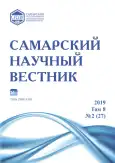The role of the Seitov Posad Tatars in the development of the Orenburg Region
- Authors: Lyubichankovskiy S.V.1
-
Affiliations:
- Orenburg State Pedagogical University
- Issue: Vol 8, No 2 (2019)
- Pages: 268-271
- Section: 07.00.00 – Historical Sciences and Archaeology
- URL: https://journals.rcsi.science/2309-4370/article/view/34328
- DOI: https://doi.org/10.17816/snv201982224
- ID: 34328
Cite item
Full Text
Abstract
The paper analyzes the role of the Seitov Posad Tatars in the development of the Orenburg Region from the moment of its foundation until the beginning of the 19th century. The reasons for the establishment of the Seitov Posad (Tatar Kargaly) near Orenburg even before the official establishment of the Orenburg province are shown. The author reviewed the resettlement process that attracted Tatars from Kazan province to the Orenburg Region. The census data are presented, indicating a consistent increase in the number of Tatars among the population of the Orenburg province. The paper shows some peculiarities of the mentality traditionally inherent to Tatar merchants, contributing to the effective implementation of trade projects. The privileges granted by the state to the residents of the Seitov Posad are noted. An explanation of the reasons that led to the endowment of the Tatar residents of the Orenburg province with a number of benefits is given. Cases of the conscious relocation of merchants from Orenburg to Seitov Posad for the purpose of supporting their own commercial projects are shown. The author notes specific historical examples that indicate the existence within the framework of state policy of integration of suburbs into a single socio-cultural space of the Russian empire of a special Tatar factor, which was important both for stabilizing the economic position of the Russian empire in the south-eastern suburbs and for acculturation of the nomadic Kazakh population.
Full Text
##article.viewOnOriginalSite##About the authors
Sergey Valentinovich Lyubichankovskiy
Orenburg State Pedagogical University
Author for correspondence.
Email: svlubich@yandex.ru
doctor of historical sciences, professor, head of History of Russia Department
Russian Federation, OrenburgReferences
- Ремнев А.В. Татары в казахской степи: соратники и соперники Российской империи // Вестник Евразии. 2006. № 4 (34). С. 5-31.
- Миллер А.И. История Романовых и национализм. Эссе по методам исторического исследования. М.: Новое литературное обозрение, 2006. 205 с.
- Денисов Д.Н. Основание Татарской Каргалы // Из истории татар Оренбуржья (280 лет Татарской Каргале): сб. материалов обл. науч.-практ. конф. Оренбург: ИПК ГОУ ОГУ, 2005. С. 13-14.
- Государственный архив Оренбургской области (ГАОО). Ф. 6. Оп. 1. Д. 483.
- Золотые страницы купечества, промышленников и предпринимателей Татарстана: в 2 т. Т. 1 / сост. Р.Р. Салихов и др. Казань: Яналиф, 2001. 340 с.
- Зобов Ю.С. Начальный этап формирования татарского населения Оренбуржья (40-е - 50-е годы XVIII в.) // Татары в Оренбургском крае: тез. докл. науч.-практ. конф. Оренбург: Изд-во ОГПУ, 1996. С. 9-11.
- Первая Всеобщая Перепись населения Российской империи. 1897 год. Уфимская губерния. Тетрадь 1, 2 / под ред. Н. Тройницкого. СПб.: Изд-во Центрального статистического комитета Министерства внутренних дел, 1904. Т. XLV. 256 с.
- Любовь и Восток: сб. эссе, документы, справочная информация, воспоминания, рассказы, стихи. М., 1994. 570 с.
- Небольсин П. Заметки на пути из Петербурга в Барнаул. СПб.: Типография И. Глазунова, 1859. 254 с.
- Даль В.И. Бикей и Мауляна // Даль В.И. Повести и рассказы. Уфа: Китап, 1981. С. 88-99.
- Свиньин П.П. Картина Оренбурга и его окрестностей // Отечественные записки. 1828. Ч. 35. № 99. С. 4-36.
- Кьюн К. Народы России. СПб.: Типография И. Глазунова, 1888. 370 с.
- Пуцыкович Ф.Ф. Татары. Чтения для народа. СПб.: Изд-во П.В. Луковникова, 1900. 16 с.
- Денисов Д.Н. Участие татар в Оренбургской пограничной торговле во второй половине XVIII в. // Оренбург вчера, сегодня, завтра: исторический и социокультурный опыт: мат-лы и тез. всерос. науч.-практ. конф., посв. 260-летию Оренбурга. Оренбург, 2003. С. 77-79.
- Апполова Н.Г. Экономические и политические связи Казахстана с Россией в XVIII - начале XIX вв. М.: Наука, 1960. 230 с.
- ГАОО. Ф. 6. Оп. 6. Д. 12356.
Supplementary files






